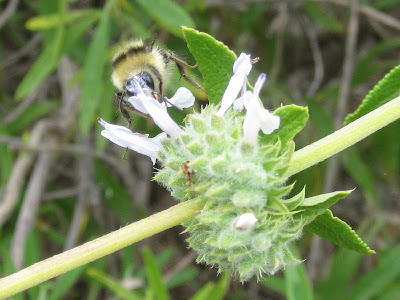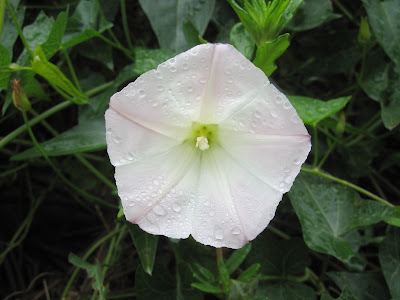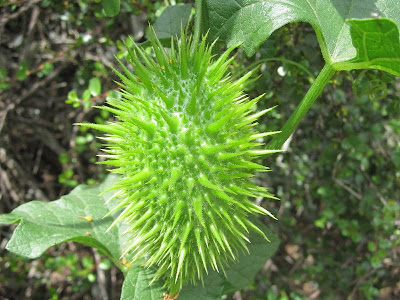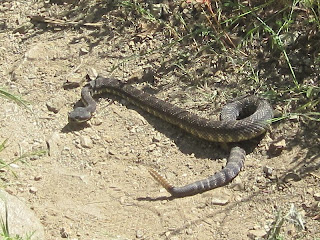
 See Eaton Canyon Hike Description at Dan's Hiking Pages
See Eaton Canyon Hike Description at Dan's Hiking Pages
With springtime blooming, I focused my outdoor pursuits this weekend on wild plants. As a hiker, I have found myself drawn to know more about plants and their habitats. Over the years I've made it a point to visit nature centers and guided nature trails to learn about plants. And gradually I've come to be familiar with many of the plants that grace the environs of my hiking adventures. I'm not a plant expert, and there are still many plants that I don't know by name, but there becomes a real sense of connectedness with my environment as I hike along the trail and greet plants my their names.

Local nature centers/trails that have been a great help to me over the years include Eaton Canyon, Monrovia Canyon, Bailey Canyon and Santa Fe Dam. But
Eaton Canyon Nature Center has really been my go-to place for learning about plants. They are open 9 to 5 Tuesday through Sunday. They have a beautiful nature center, three self-guided nature trails, and several habitat gardens. It's one thing to look at plant photo in a book or on a computer, but nothing compares with standing there on a nature trail, seeing the plant in real life, and having a nice little sign that tells you exactly what the plant is.
So this weekend involved two plant adventures. On Saturday early evening I took the five-minute drive to the trailhead for Van Tassel Ridge/Fish Canyon to hang out with plants along side the San Gabriel River. Then on Sunday afternoon I headed to Altadena to revisit the nature trails of Eaton Canyon Nature Center. Below features some of the plants from those outings:
San Gabriel River Golden current
Golden current (
Ribes aureum) is a native deciduous shrub among several members of the gooseberry family (Grossulariaceae) found in the San Gabriels. Its tiny yellow flowers, for which it gets its name, "golden," bloom from January through April. The absence of spines (little needle-like thorns) help distinguish the currants from gooseberries.
 Golden current
Golden current (
Ribes aureum) produces small, smooth-skinned berries, first green, then they mature into yellow, orange, red or black. The ripe berries are edible but aren’t sweet like commercially grown currants.
 Mediterranean mustard
Mediterranean mustard or shortpod mustard (
Hirschfeldia incana) is a non-native biennial or perennial herb to subshrub introduced from the Mediterranean and can be quite invasive in local habitats. It grows profusely and produces allelopathic chemicals that prevent germination of native plants. It looks very much like black mustard (
brassica nigra), which grows much taller.
 Deerweed
Deerweed (
Lotus scoparius) is native herb or shrubby bush in the pea family that grows up to 3 to 4 feet tall. It's common in our coastal sage and chaparral plant communities and easy to learn its identity because there is really nothing else to confuse it with.
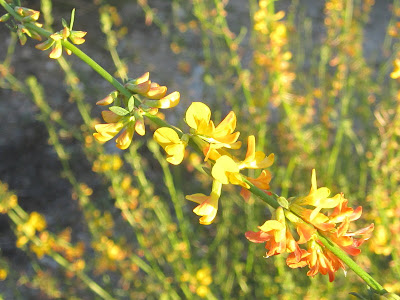 Deerweed
Deerweed (
Lotus scoparius) has tiny yellow flowers along its long, skinny, green stems. It generally blooms from March through August, but blossoms can been seen early as January. It's an important honeybee plant. The flowers turn from yellow to orange after they have been pollinated, which is a nice way to alert pollinating insects to not waste their time on it.
 Brittlebush
Brittlebush (
Encelia farinose) is a native shrub in the sunflower family and blooms from March to July. The stems easily snap under pressure, thus the name brittlebush. The silvery white leaves look similar to white sage, and without the presence of flowers, the novice might confuse the two. But the robust aroma of the sage clearly sets it apart.
 White sage
White sage (
Salvia apiana) is a native shrub among several sages and aromatic plants that make the chaparral smell wonderful. This was an important plant for Native Americans. It's also an important bee plant, thus the name
apiana, which refers to honeybees.
 Chia
Chia (
Salvia columbariae) is a native annual herb in the mint family. It's flowering structure looks similar to black sage (
Salvia mellifera), but chia is a small ground plant that sends up it's flowering stems to a height of only 12 to 24 inches.
 Chia
Chia (
Salvia columbariae), usually produces 2 spiky ball-like purple flower clusters on slender stems. Only a few of the buds are open at one time. The plant is a high-protein seed/food plant and was used by the Native Americans and today is sold in health stores. The name
Salvia means healing and wellness.
 Showy penstemon
Showy penstemon (
Penstemon spectabilis) is a native perennial herb that grows up to 3 to 4 feet tall. It blooms from April through June.
Eaton Canyon Fuchsia-flowered gooseberry
Fuchsia-flowered gooseberry (
Ribes speciosum) is a perennial shrub in the gooseberry family (Grossulariaceae) among several gooseberry and currant species in our local foothills and mountains.
 Fuchsia-flowered gooseberry
Fuchsia-flowered gooseberry (
Ribes speciosum) blooms from January to May. It has spiny stems and fruit, as do other gooseberry species, which distinguish them from the currants.
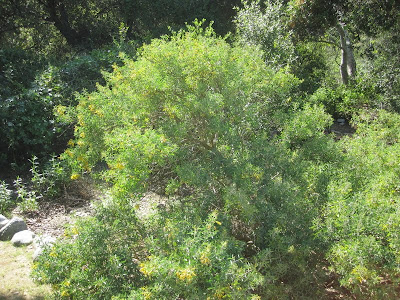 Bladderpod
Bladderpod (
Isomeris arborea) is a native evergreen tree-like shrub that is found in many habitats and grows up to 10 feet tall. Its leaves and flowers produce disagreeable odor.
 Bladderpod
Bladderpod (
Isomeris arborea) produces showy clusters of yellow flowers and distinctive inflated green pods. When dry, the pod resembles a paper lantern that rattles (the seeds inside rattle around).
 Scarlet bugler
Scarlet bugler (
Penstemon centranthifolius) is a native perennial herb in the figwort family (not to be confused with California fuchsia (
Epilobum canum). It grows up to 6,000 feet in elevation, so you may see it along the trail above the chaparral in the pine forests.
 Rattlesnake!
Rattlesnake! I know that this guy is not a plant, but I couldn't resist featuring him here. He (or she?) is on exhibit at Eaton Canyon Nature Center and labeled a
Southern Pacific Rattlesnake (
Crotalus oreganus). It's a good reminder that these venomous pit vipers are a native part of our local habitats.
 California coffeeberry
California coffeeberry (
Rhamnus californica) is a native evergreen shrub in the buckthorn family and grows up to 16 feet tall. It produces yellow-green flowers from May to June that turn into little black berries that resemble coffee beans. But don't try to brew a cup of joe from them; the won't yield coffee!
 Popcorn flower
Popcorn flower (
Cryptantha muricata, maybe) is an annual herb that produces tiny white flowers from February to June. I read that there are about 11 different species of
Cryptantha in the San Gabriel foothills and canyons and they can be very difficult to distinguish. Complicating matters, some members of the
Plagiobothrys genus appear almost identical to those of
Cryptantha. So feel free to call any of those plants "popcorn flower."
 Dodder
Dodder (
Cuscuta spp.) is a unique and distinctive native plant widespread in the San Gabriels and beyond. It has many common names but the one I'm most familiar with is witches hair. It is a parasitic vine that takes its food supply from a host plant. The plant that I see it most on is California buckwheat, pictured here. Thankfully, dodder does not usually harm the host plant.

 Recommended resource: Plants of the San Gabriel Mountains: Foothills and Canyons / Interpretive Guide on CD
Recommended resource: Plants of the San Gabriel Mountains: Foothills and Canyons / Interpretive Guide on CD (Nature at Hand, 2007) by Gabi and Cliff McLean. The McLeans have been associated with Eaton Canyon Nature Center for many years and have played a vital role in educating the public about nature. They have created an amazing interactive CD featuring 258 plants with 1,800 quality photos. They have really made botany enjoyable and accessible for the non-botanists, like me. Detailed descriptions are given for each plant in easy-to-understand language. An extensive glossary of terms is only a click away and they provided audio pronunciations for botanical names and key botanical words. A variety of search options makes it easy to find the plant you are looking for. This user-friendly resource has been immensely helpful to me as a reference in plant identification and writing my blurbs about plants. It's the best 20 bucks I've ever spent on a plant guide! To purchase the CD, visit
www.natureathand.com.
 See Eaton Canyon Hike Description at Dan's Hiking Pages
See Eaton Canyon Hike Description at Dan's Hiking Pages
 See Plants and Wildflowers of the San Gabriel Mountains at Dan's Hiking Pages
See Plants and Wildflowers of the San Gabriel Mountains at Dan's Hiking Pages
 Earth Day celebrations by the City of Glendora occasioned heading over to Colby Trail for a docent-led hike. I was eager to see what is in bloom and particularly get a look at the endangered thread-leaved brodiaea (Brodiaea filifolia). I had also received an email this week from a hiker who told me there were new trail signs with mileage notations that were different from what I have posted on my website. So of course I'd want to check that out. Since my wife had the car for the weekend, I rode my bike to nearby Glendora.
Earth Day celebrations by the City of Glendora occasioned heading over to Colby Trail for a docent-led hike. I was eager to see what is in bloom and particularly get a look at the endangered thread-leaved brodiaea (Brodiaea filifolia). I had also received an email this week from a hiker who told me there were new trail signs with mileage notations that were different from what I have posted on my website. So of course I'd want to check that out. Since my wife had the car for the weekend, I rode my bike to nearby Glendora. I arrive at the trailhead at the upper end of Loraine Avenue at 11:15 and immediately start photographing the beautiful stand of matilija poppy that graces the trailhead gateway. Just then my friend, Dr. Ann Croissant, who leads the Glendora Community Conservancy, drives up. They do a great job in stewarding the trail and surrounding open space. As we chatted, a group of hikers led by Bob Bennett finished a hike. Bob is on the conservancy board and is an ISA certified arborist. Shortly, two ladies join us and so the four of us began sauntering up the trail.
I arrive at the trailhead at the upper end of Loraine Avenue at 11:15 and immediately start photographing the beautiful stand of matilija poppy that graces the trailhead gateway. Just then my friend, Dr. Ann Croissant, who leads the Glendora Community Conservancy, drives up. They do a great job in stewarding the trail and surrounding open space. As we chatted, a group of hikers led by Bob Bennett finished a hike. Bob is on the conservancy board and is an ISA certified arborist. Shortly, two ladies join us and so the four of us began sauntering up the trail.

 Open space is a good thing! After Bob shows us the vernal poor and some other interesting things in this area, we head back. At the junction we part ways at 1:25 as they return to the trailhead and I continue up the main trail. The weather is gorgeous and the views out over the valley are striking. I enjoy strolling along and taking pictures. The non-native grasses are already turning yellow. I’m pleased with a beautiful stand of grape soda lupine to photograph. It really does smell like grape soda. I’m delighted to discover an occurrence of the tiny scarlet pimpernel. My first encounter with it was last week at Rancho Santa Ana, so it’s great to find it in the wild. I finally reach Glendora Mountain Road at 3:00, covering a whopping half mile since parting with the group at 1:25. It’s not a lot of mileage but I shot 290 pictures in that span. Love digital!
Open space is a good thing! After Bob shows us the vernal poor and some other interesting things in this area, we head back. At the junction we part ways at 1:25 as they return to the trailhead and I continue up the main trail. The weather is gorgeous and the views out over the valley are striking. I enjoy strolling along and taking pictures. The non-native grasses are already turning yellow. I’m pleased with a beautiful stand of grape soda lupine to photograph. It really does smell like grape soda. I’m delighted to discover an occurrence of the tiny scarlet pimpernel. My first encounter with it was last week at Rancho Santa Ana, so it’s great to find it in the wild. I finally reach Glendora Mountain Road at 3:00, covering a whopping half mile since parting with the group at 1:25. It’s not a lot of mileage but I shot 290 pictures in that span. Love digital!
 I turn around and head down. At the junction, 260 feet below GMR, I turn left and take Colby-Dalton Trail, which descends east .47 mile to Little Dalton Wash. It’s really a beautiful trial with rich vegetation. The down side is that once at the bottom, one has to climb a paved service road up to the berm trail. But I enjoy the scenery and exercise.
I turn around and head down. At the junction, 260 feet below GMR, I turn left and take Colby-Dalton Trail, which descends east .47 mile to Little Dalton Wash. It’s really a beautiful trial with rich vegetation. The down side is that once at the bottom, one has to climb a paved service road up to the berm trail. But I enjoy the scenery and exercise.












